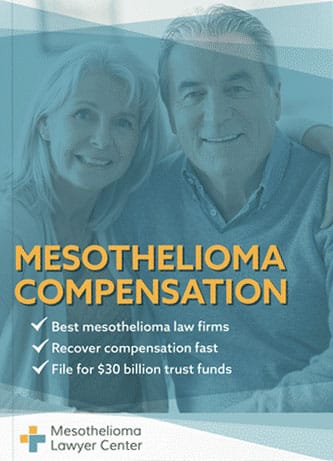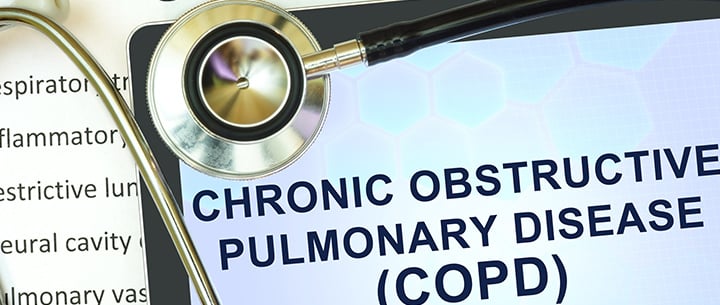Chronic obstructive pulmonary disease (COPD) is a respiratory illness that can be related to asbestos exposure. It can develop as a complication of asbestosis, a chronic lung disease caused by asbestos exposure. COPD is one of the most common pulmonary diseases and manifests in chronic bronchitis and emphysema.
If you were diagnosed with mesothelioma, asbestos-related lung cancer, or asbestosis, you might be entitled to considerable compensation. Fill out our form to receive our free Financial Compensation Packet. Our packet is loaded with information on experienced mesothelioma attorneys in your area, how to file a claim for asbestos trust funds, how to get paid in 90 days, and more.


FREE Financial Compensation Packet
- Info on law firms that will recover your HIGHEST COMPENSATION
- Learn how to get paid in 90 days
- File for your share of $30 billion in trust funds

What Is COPD?
Chronic obstructive pulmonary disease is really a group of respiratory diseases. It is chronic and is characterized by reduced airflow, which causes respiratory symptoms.
COPD is chronic and progressive. It gets worse over time, and there is no cure. Treatments help slow the progression of COPD and manage symptoms. There are two main types of COPD:
- Chronic bronchitis
- Chronic emphysema
Regardless of type, COPD is characterized by factors that make breathing more difficult:
- Damaged and scarred tissue
- Loss of elasticity
- Increased mucus
- Inflammation and thickening of tissue
Asbestos and COPD: Does Asbestos Cause COPD?
Asbestos exposure can cause several serious illnesses. Mesothelioma, lung cancer, and asbestosis are the diseases most associated with asbestos.
Long-term asbestos exposure is a secondary cause of COPD, typically after someone develops asbestosis. Asbestosis is a progressive but non-malignant disease caused by asbestos exposure. It is characterized by scarring of lung tissue.
People diagnosed with mesothelioma can also develop COPD, although asbestosis and COPD are more common.
The top direct cause of COPD is smoking, whether through cigarettes, cigars, or pipes, but many people have developed COPD after prolonged asbestos exposure.
Asbestos exposure alone does not directly cause COPD. However, people with COPD risk further lung damage around asbestos fibers.
Studies Link Asbestos and COPD
Studies have found that COPD rates are higher among people who worked with asbestos. For instance, COPD prevalence is nearly 19% in insulation workers who handled asbestos insulation.
Research has also found an increased rate of COPD in nuclear workers with the Department of Energy. These workers were also likely to be around asbestos materials.
Who Is at Risk for Asbestos-Caused COPD?
Workers in the shipbuilding, construction, and energy-generating industries, in particular, are at a heightened risk of developing asbestos illnesses, placing them at risk for COPD.
Veterans who served in the armed forces throughout much of the 20th Century are also at risk of developing COPD and other serious life-threatening illnesses caused by asbestos exposure.
Since asbestos-derived products were used extensively in the United States across a broad range of products until the 1980s, millions of Americans were exposed to asbestos fibers.
If someone constantly inhales or swallows asbestos, the resulting buildup of its fibers may lead to blocked airways and extensive damage to lung tissue that triggers emphysema or chronic bronchitis.
Can Asbestosis Be Mistaken for COPD?
Because asbestos illnesses are much less common, COPD is a possible misdiagnosis for asbestosis and other asbestos illnesses. Other typical misdiagnoses include pulmonary fibrosis and pneumonia.
Anyone with a COPD diagnosis and a history of asbestos exposure should seek a second opinion to rule out asbestos illnesses.
Symptoms of COPD
COPD usually manifests itself in forms that restrict airflow in the lungs and bronchial tubes:
- Chronic bronchitis, which is characterized by a long-term cough with sputum (mucus discharge)
- Emphysema, which is characterized by a progressive and irreversible breakdown of lung tissue
According to the National Institutes of Health (NIH), most patients with COPD suffer from a combination of chronic bronchitis and emphysema.
One of the first indicators of COPD is a persistent, permanent cough. The cough is often accompanied by sputum, a liquid substance discharged from the respiratory system.
Sputum consists mainly of mucus but also includes pus, bacteria, cell fragments, and, in severe cases, blood. Another common symptom of COPD is shortness of breath.
Other symptoms of COPD include:
- Difficulty with inhaling/exhaling
- Wheezing
- Respiratory infections
- Unexplained weight loss
- Tightness in the chest
- Fatigue
- Apnea (shortness of breath)
Since COPD is a progressive disease, many people are unaware they are sick.
How COPD is Diagnosed: Exams and Tests
Although COPD is an insidious disease that develops slowly, it can be detected through various exams and tests.
Spirometry is the principal diagnostic method used by doctors to determine COPD. It is the most common pulmonary function test and involves using a spirometer to measure the volume and flow of air a person breathes in and out.
A patient blows a breath of air as hard as possible into the spirometer, which tests lung capacity. The results are instantaneous.
These types of tests do not involve physical exertions, chemical tests, or drawing of blood or tissue samples.
A physician can also use a stethoscope to listen to the lungs. However, COPD often does not manifest with audible signs, even in the respiratory system.
Visual detection methods, such as X-rays and computerized tomography (CT) scans, are more effective than using stethoscopes.
In most instances, X-rays and CT scans may detect damage to lung tissue. However, the imagery doesn’t help identify other symptoms and signs of COPD. Therefore, additional tests and exams usually accompany X-rays and CT scans.
Doctors may also order arterial blood tests to measure oxygen levels in the patient’s circulatory system.
Risk Factors For COPD
As noted earlier, the leading cause of COPD is smoking. However, other risk factors can trigger the condition. The risk factors for COPD are:
- Exposure to dangerous levels of air pollution and second-hand smoke from cigarettes and other tobacco products
- Exposure to toxic gases, fumes, and airborne asbestos particles
- Frequent use of cooking fire in a poorly ventilated space
COPD Treatment Options
There is currently no cure for COPD. However, COPD can be managed through various medicines and therapies.
These treatments not only slow down the progress of COPD’s destructive effects on the respiratory system, but they also alleviate the disease’s symptoms and help improve the patient’s quality of life.
According to the ALA, there isn’t the best method to treat COPD. Each patient’s condition is unique, and the attending physician will work closely with the patient to set up an individualized plan based on specific symptoms and needs.
Doctors have several options regarding which medicines to prescribe to patients with COPD. These options include:
- Bronchodilators are medications distributed by inhalers. These medications relax the muscles around the tubes and allow a patient to breathe more easily. They come in either short-acting or long-acting types and include ipratropium, salmeterol, formoterol, or albuterol.
- Anti-inflammatory medications, such as montelukast and roflumilast, reduce swelling and the production of mucus in the breathing tubes.
- Steroids delivered by inhalers are sometimes prescribed to reduce inflammation in the lung tissue.
- Combined therapy mixes two or more of the above medications.
In extreme cases of COPD, or if a patient is suffering from a flare-up, a doctor may order other types of treatment, including:
- Oxygen therapy
- Delivery of bronchodilators through a nebulizer
- Machine-assisted respiratory therapy
- Steroids delivered in pill form or intravenously
Another form of treating COPD is implementing a medically-approved exercise plan and physical therapy. While physical exercise does not reverse the effects of the condition, it can help patients learn to breathe differently and maintain the strength of leg muscles.
Patients with COPD should make an exercise plan with their doctor or a physical therapist to determine how far to walk, the proper breathing methods to use while exercising, and avoiding habits such as speaking while walking.
COPD patients who smoke tobacco products must cease smoking. Per the ALA and NIH, smoking is the leading cause of COPD. Quitting right away will slow down the destructive effects of COPD on lung tissue.
Legal Help for COPD
Keep in mind that if you have mesothelioma, asbestos-related lung cancer, or asbestosis, you may be eligible for considerable compensation. Remember to fill out our form to get your free Financial Compensation Packet, with information on asbestos and mesothelioma lawyers in your area.

Paul Danziger
Reviewer and EditorPaul Danziger grew up in Houston, Texas and earned a law degree from Northwestern University School of Law in Chicago. For over 25 years years he has focused on representing mesothelioma cancer victims and others hurt by asbestos exposure. Paul and his law firm have represented thousands of people diagnosed with mesothelioma, asbestosis, and lung cancer, recovering significant compensation for injured clients. Every client is extremely important to Paul and he will take every call from clients who want to speak with him. Paul and his law firm handle mesothelioma cases throughout the United States.
References
- American Lung Association. (2023, April 28). COPD Symptoms & Diagnosis.
Retrieved from: https://www.lung.org/lung-health-and-diseases/lung-disease-lookup/copd/symptoms-causes-risk-factors/symptoms.html - Wilken, D., Velasco Garrido, M., Manuwald, U., and Baur, X. (2011, July 26). Lung Function in Asbestos-Exposed Workers, a Systematic Review and Meta-Analysis. J. Occup. Med. Toxicol. 6(21). doi: 10.1186/1745-6673-6-21.
Retrieved from: https://www.ncbi.nlm.nih.gov/pmc/articles/PMC3164601/ - Mayo Clinic. (2022, February 11). Asbestosis.
Retrieved from: https://www.mayoclinic.org/diseases-conditions/asbestosis/symptoms-causes/syc-20354637 - MedlinePlus. (2021, October 5). COPD.
Retrieved from: https://medlineplus.gov/copd.html
